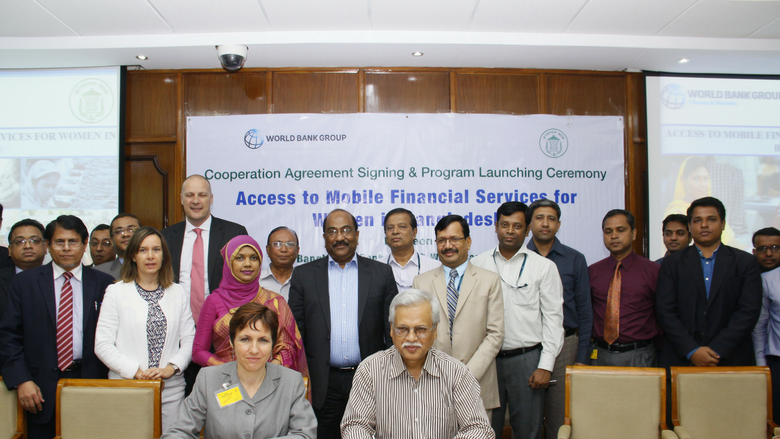The World Bank Group’s (WBG) Universal Financial Access 2020 (UFA2020) envisions that all adults worldwide will have access to a transaction account or an electronic instrument to store money, send payments and receive deposits by 2020.
The lack of financial inclusion is a pressing issue in Bangladesh, and women are disproportionately excluded: only 26% of women have accounts at financial institutions. Mobile financial services (MFS) are well positioned to deliver financial services to segments that can prove prohibitively expensive for banks, such as women in rural areas. Despite the strong growth of the mobile financial services (MFS) market, only 6% of women have MFS accounts.
Led by Sr. Financial Sector Specialist Ananya Wahid Kader, the WBG has spearheaded an initiative in Bangladesh to transform women’s financial inclusion through increased MFS adoption. Here are her recommendations and insights on how to address the sector-wide gender gaps and market structural limitations.
How can MFS projects holistically improve women’s financial inclusion, including encouraging diversity of services?
There is a widespread gender gap in access to financial services in developing countries, including Bangladesh, where Mobile Financial Service providers have not made any outreach efforts in distribution channels or product offerings that are optimized for the needs of female clients. There is an absence of data that demonstrates the prospects of investing in the women segment. On the demand side, there is limited awareness among women on how MFS can meet their financial needs.
We took a holistic approach to address these barriers by designing our women MFS project by first conducting a nationwide market study to understand the women’s market. We are now piloting tools and products to demonstrate their value. They will be housed at the central bank as public goods and establish the business case for investment in the female MFS market.
Is there a gender preference in agents? If so, how do we create a supply of agents that reflect that preference?
Currently 99% of MFS agents in Bangladesh are male. Our market study reflects that the majority of existing and potential female MFS users prefer female agents. In the socio-cultural context of the country, women are uncomfortable with sharing their personal details with male agents, and there have been anecdotes of harassment from male agents.
MFS providers have not taken any action to optimize their distribution networks to address this gender preference. For this reason, we developed the “Women Agent Acquisition Toolkit” for MFS providers. The Toolkit is designed to address women’s lower levels of financial and technical literacy, and emphasizes simulations, role-playing and soft skills. We have also trained field staff to ensure that they can effectively utilize the Toolkit to identify and train female agents.
How can smartphone technology be harnessed to address the needs specific to women users?
Sixteen percent of women in the country have smartphones and the percentage is growing. Subsequently, MFS providers and financial sector stakeholders are increasingly finding reason to design smartphone apps that will improve the user interface for female clients.
MFS is currently offered through Unstructured Supplementary Service Data (USSD) menus which can be used on any type of mobile device. However, there are significant drawbacks from having a USSD user interface, most notably that its menus are devoid of local language content and services are not user-friendly for those with lower levels of literacy.
This is where smartphone apps are useful: in Bangladesh, apps can offer Bangla language content, images and a richer user interface that will improve the ability of women with low literacy to carry out MFS transactions. Apps can also be used to offer dedicated financial literacy content to female users.
Why did the WBG choose to engage in the Ready-Made Garment and textile industries to establish a business case for female-inclusive Mobile Financial Services?
The economically crucial textile sector is the most significant employer of women in the country: an estimated 80% of garments factory workers are women. The industry employs 3.4 million women, of whom 81% are unbanked. Thus, focusing on the garments sector will help financially include a significant number of women. 90% of garment factories pay their workers in cash. Disbursing wage payments through MFS will lead to these workers opening accounts and subsequently becoming financially included.
The garments industry’s lead is influential for other manufacturing industries in Bangladesh and once garments sector wage digitization has been demonstrated successfully, other industries which employ large numbers of women will follow suit.
In what other ways can the WBG and other development partners support the MFS industry in increasing adoption among women?
Awareness and financial literacy are barriers to female MFS adoption. Broad based awareness campaigns are expensive and it is difficult for MFS providers to invest in such strategies given the unproven female market. The WBG and other development sector entities can encourage such investments with positive social externalities, such as through performance based matching grant schemes. Through partnerships and targeted technical advisory engagements, development partners can support the delivery of financial literacy content over innovative digital channels and disseminate knowledge on best practices.
We are undertaking a series of roadshows to improve the financial literacy of unbanked women. Using short and succinct content, our program can reach a large audience for targeted financial literacy messages. Sustained engagement on such efforts can address demand side awareness and literacy constraints.

